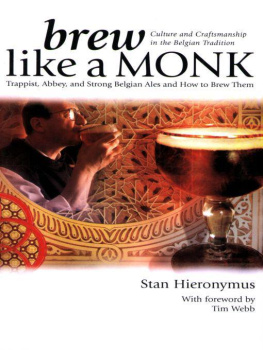Stan Hieronymus - Brewing with Wheat
Here you can read online Stan Hieronymus - Brewing with Wheat full text of the book (entire story) in english for free. Download pdf and epub, get meaning, cover and reviews about this ebook. year: 2010, publisher: Brewers Publications, genre: Art. Description of the work, (preface) as well as reviews are available. Best literature library LitArk.com created for fans of good reading and offers a wide selection of genres:
Romance novel
Science fiction
Adventure
Detective
Science
History
Home and family
Prose
Art
Politics
Computer
Non-fiction
Religion
Business
Children
Humor
Choose a favorite category and find really read worthwhile books. Enjoy immersion in the world of imagination, feel the emotions of the characters or learn something new for yourself, make an fascinating discovery.

- Book:Brewing with Wheat
- Author:
- Publisher:Brewers Publications
- Genre:
- Year:2010
- Rating:3 / 5
- Favourites:Add to favourites
- Your mark:
- 60
- 1
- 2
- 3
- 4
- 5
Brewing with Wheat: summary, description and annotation
We offer to read an annotation, description, summary or preface (depends on what the author of the book "Brewing with Wheat" wrote himself). If you haven't found the necessary information about the book — write in the comments, we will try to find it.
Brewing with Wheat — read online for free the complete book (whole text) full work
Below is the text of the book, divided by pages. System saving the place of the last page read, allows you to conveniently read the book "Brewing with Wheat" online for free, without having to search again every time where you left off. Put a bookmark, and you can go to the page where you finished reading at any time.
Font size:
Interval:
Bookmark:
WHEAT
The Wit and Weizen of World Wheat Beer Styles
by Stan Hieronymus
Brewers Publications
A Division of the Brewers Association
PO Box 1679, Boulder, Colorado 80306-1679
www.BrewersAssociation.org
Copyright 2010 by Brewers Association
All rights reserved. No portion of this book may be reproduced in any form
without written permission of the publisher. Neither the authors, editor nor
the publisher assume any responsibility for the use or misuse of information
contained in this book.
Printed in the United States of America.
10 9 8 7 6 5 4 3 2
ISBN: 0-937381-95-0
ISBN-13: 978-0-937381-95-3
ISBN (epub edition): 978 1 938469 08 4
Library of Congress Cataloging-in-Publication Data
Hieronymus, Stan.
Brewing with wheat : the wit and weizen of world wheat beer styles / by
Stan Hieronymus.
p. cm.
Includes bibliographical references and index.
ISBN 978-0-937381-95-3
1. Wheat beer. 2. Brewing. I. Title.
TP577.H464 2010
641.23--dc22
2009048851
Publisher: Kristi Switzer
Technical Editor: Ashton Lewis
Copy Editing and Index: Daria Labinsky
Production and Design Management: Stephanie Johnson
Cover and interior design: Julie Korowotny
Cover Photography by Jon Edwards Photography and iStockphoto.com/ Valentin Casarsa
Special thanks to Sahm and Boelter for the glassware provided for the cover photos.
Interior Photos: Stan Hieronymus unless otherwise noted.
To the memory of Michael Jackson, because
all books that would broaden what we know about
beer should be so dedicated until further notice.
By Yvan De Baets
About the Book
My advice to anybody writing a book is to start with a group of people to help you who are as generous as those in the brewing community, and then line up the best copy editor you can find. I would not have started this project had I not known my fastidious wife, Daria Labinsky, would be at the end to help make sense of what I wrote. She and our daughter, Sierra, are the best traveling companions a man could wish for. Thank you, Sierra, for spending part of your birthday at Bayerischer Bahnhof Gasthaus and Gose Brauerei in Leipzig, not a dream location for most girls turning twelve.
Dan Carey of New Glarus Brewing likened me to the television detective Columbo. You are leaving, then there is always one more question, he said. I am particularly grateful to all those who answered the extra questions. There are far too many to list, but the particularly patient included Carey, Hans-Peter Drexler, Eric Toft, Steven Pauwels, and Jason Perkins.
To write about these beers requires understanding the history behind them and the culture surrounding them, not a slam dunk for an American who grew up in central Illinois and struggled with high school German. Were it not for the generosity of Ron Pattinson and Yvan De Baets this would be a much lesser book technically and culturally. Martyn Cornell, Carl Miller, Derek Walsh, Bob Hansen, Don Bechtel, and Gordon Strong further helped in matters related to history and brewing science.
Thanks to the brewers who contributed recipes: Jean-Franois Gravel, Bill Aimonetti, Todd Ashman, Pauwels, and Kristen England. And double thanks to England for additional insights.
The final step, producing a book, was made easier by Kristi Switzer, who took the reins at Brewers Publications from Ray Daniels, and Julie Korowotny. I sleep much better at night because Ashton Lewis agreed to be the technical editor, and particularly value the suggestions he made to make the book more understandable.
I cant overstate my appreciation for everything Yvan De Baets contributed, including the Foreword, but also all the work he put into the third chapter at a time when he was busy getting his own brewery going. Its not easy keeping the brewing world honest, but hes doing more than his share.
When my friend Stan asked me to participate in his new book, I had two reactions. The first one was pride. Being asked to contribute to the work of such a knowledgeable beer writer is definitely something! The second was: Wheat beers? How boring! Indeed, if the German weizens are without a doubt a fascinating style, and if it is really easy to find plenty of exquisite examples of them, the same is certainly not true with their Belgian or Belgian-like counterparts. Far from that. In my country, wheat beers (witbieren in Dutch, bires blanches in French) have been considered as a sort of commodity for a few decades. The big boys have to have one in their range, with as their main target the people who dont like beer so much and the women (yes, a lot of brewers still have outdated macho views of their own customers). And, as always, a lot of small brewers just imitate them. In turn all those are then often imitated by foreign brewers. As a result, and even if very nice examples do exist, far too many of the white beers to be found around the world are sweetish coriander soups resembling spicy lemonade with some alcohol in it.
Yet, white beers, and, more generally, wheat beers, were once something else in Belgium. And digging into the past shows a fantastic variety of fascinating styles. To correctly understand the picture, one has to keep in mind that, in the past in Belgium, wheat was certainly as important as barley in beer brewing. When talking about the general characteristics of Belgian brewing, local doctor Jean-Baptiste Vrancken wrote that in Belgium almost all the beers, even the ones called Orge (barley), contained 50 percent wheat. He added that when a Belgian brewer wanted to make a stronger beer, he wont add more barley and wheat, but wheat only. Indeed, in the old books, one can find an impressive list of old Belgian styles containing that cereal, and this without even counting the classical trio Louvains (or Leuvens) white, Hoegaerden, and Peeterman. Name it: Brune de Malines, Saison de Lige, Bire de Ath, Grisette, Orge dAnvers, Seef (Antwerps White), Lambic de Bruxelles, Bire de Diest, Caves de Lierre, Bire de Putte, Bire de Tirlemont, Bire de Jodoigne, Bire de Bois-le-Duc, Saison de Wallonie (eventually), Brune & Blanche du Pays Wallon, etc. And there were more! The reasons? According to Vrancken, wheat imparts smoothness and bouquet.
But let another Belgian tell his version: Wheat was there, grown anyway for the making of bread, and because it didnt have to undergo a malting process it was cheaper than malted barley. Yes, the Belgians love to drink, but they are also pragmatic people. Another consideration has to be added, though: Until the end of the nineteenth century, the brewers strongly believed that the use of wheat helped the beer to keep longer (even if the classical whites had a very short shelf life). Maybe this is related to the strength bread gives to human bodies? It reminds us anyway that, as the histories of beer and bread are so closely related, it is more than probable that wheat was used for making beer since beer has existed. It is now proven that wheat and barley are at the origin of civilisation, as they wanted to be supplied all the year roundwhich demanded they cultivate them. Was it for bread or for beer? Some extremely serious paleo-anthropologists strongly believe it was for the latter, which, by the way, would make beer one of the keystones that permitted civilisation to be bornnothing less!
Tracking those old beersGerman, Belgian, whatevermakes one realize that the key to the old styles, probably even more than the recipes themselves, was to be found in the local microflora of each brewery. Vrancken reports eighteenth and nineteenth century trials, in which brewmasters were sent from a brewery to another similar one, with all their equipment, raw material, and techniques. Sometimes the grains were even crushed in the first brewery to mimic the process perfectly. They never succeeded in making the same beer in the next village! Mixed fermentation was the norm, with local consortia of yeasts and bacteria working in a beautiful symbiosis.
Font size:
Interval:
Bookmark:
Similar books «Brewing with Wheat»
Look at similar books to Brewing with Wheat. We have selected literature similar in name and meaning in the hope of providing readers with more options to find new, interesting, not yet read works.
Discussion, reviews of the book Brewing with Wheat and just readers' own opinions. Leave your comments, write what you think about the work, its meaning or the main characters. Specify what exactly you liked and what you didn't like, and why you think so.








